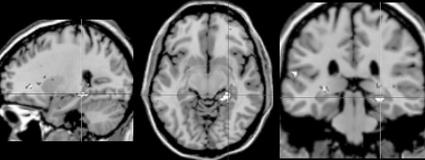ANTIEPILEPTOGENIC DRUG EFFECTS IN fMRI LANGUAGE MAPPING
Abstract number :
1.284
Submission category :
Year :
2004
Submission ID :
4312
Source :
www.aesnet.org
Presentation date :
12/2/2004 12:00:00 AM
Published date :
Dec 1, 2004, 06:00 AM
Authors :
1Todd Constable, 1Nicole Hanick, 1Jagriti Arora, 1Nallakkandi Rajeevan, 2Michael Westerveld, 2Susan Spencer, and 2Dennis Spencer
It is becoming increasingly recognized that baseline brain state must be considered when evaluating fMRI results. Antiepileptogenic medications are known to alter baseline flow and metabolism. Functional MRI, produces signal changes dependent upon a complex interaction between blood flow, oxygenation, volume, oxygen extraction fraction, and oxygen consumption, some of which may be influenced by medications. This work examined 37 patients with language mapping, to investigate the influence of antiepileptogenic meds on the activation patterns. Imaging was performed on a 1.5T GE Signa. Patient population consisted of patients with intractable epilepsy who were candidates for surgical intervention (37 patients (23F, 14M), mean age 34.8y, mean duration of epilepsy 16.9y). Patients presented with the following meds: 13 Carbamazepine, 9 Phenytoin, 13 Lamotrigine, 3 Oxcarbamazepine, 8 Valproate, 3 Gabapentin, 4 Topiramate, and 15 Levitiracetam. Drugs were grouped according to mechanism (ion channel, multiple mechanisms, and unknown) and a general linear model was run on the % signal change activation maps across subjects. This allowed hypothesis testing for a main effect of drug in the activation maps. Effects of age at onset, FSIQ, and patient age were also included in the GLM. Functional imaging was performed using previously published language paradigms (Constable et al, NeuroImage 2004). The ion channel blockers led to increased activation in left posterior STG and bilateral insula in the auditory sentence task and increased posterior cingulate and right insula in the reading task. The multiple mechanism drugs had little impact in sentence-reading, and led to increased right STG and right insula in the auditory task. The Levitiracetam led to increased activation in left IFG during reading and increased caudate and hippocampal activation (shown below) in the auditory task. Age at onset was associated with increased activation in medial PFC, whereas FSIQ was positively correlated to activation in both the left IFG and STG.[figure1] The results provide evidence of drug effects in fMRI. The results are modality dependent, indicating drug effects may be regional in nature. A targeted study of these effects could reveal not only what drug effects occur, but with a larger in-magnet behavioral task battery, it would be possible to associate specific changes in activation patterns with specific changes in the performance across a number of different tasks. (Supported by NIH NS40497, NS38467, EB00473)
